THE NEW LIBRARY OF PSYCHOANALYSIS
General Editor: Dana Birksted-Breen
Doubt, Conviction and the
Analytic Process
Selected Papers of Michael Feldman
Michael Feldman
Edited by Betty Joseph
First published 2009
by Routledge
27 Church Road, Hove, East Sussex BN3 2FA
Simultaneously published in the USA and Canada
by Routledge
711 Third Avenue, New York, NY 10017 (8th Floor)
Routledge is an imprint of the Taylor & Francis Group, an Informa business
2009 Michael Feldman
Typeset in Bembo by RefineCatch Limited, Bungay, Suffolk
Paperback cover design by Sandra Heath
All rights reserved. No part of this book may be reprinted or reproduced or utilized in any form or by any electronic, mechanical, or other means, now known or hereafter invented, including photocopying and recording, or in any information storage or retrieval system, without permission in writing from the publishers.
This publication has been produced with paper manufactured to strict environmental standards and with pulp derived from sustainable forests.
British Library Cataloguing in Publication Data
A catalogue record for this book is available from the British Library
Library of Congress Cataloging-in-Publication Data
Feldman, Michael.
Doubt, conviction, and the analytic process: selected papers of Michael Feldman / Michael Feldman.
p.; cm.
Includes bibliographical references and index.
1. Psychoanalysis. I. Title.
[DNLM: 1. Physician-Patient RelationsEssays. 2. Psychoanalytic TherapyEssays. WM 460.6 F312d 2009]
RC504.F36 2009
616.89'17dc22
2008035057
ISBN 9780415479349 (hbk)
ISBN 9780415479356 (pbk)
Contents
| ROY SCHAFER |
| BETTY JOSEPH |
The Oedipus complex: manifestations in the inner
world and the therapeutic situation |
Manifestations of the death instinct in the
consulting room |
Reading Michael Feldman, one has a sense of having been welcomed into the workshop of a master analyst to think with him as he reflects on key concepts and clinical problems. Few psychoanalytic writers convey as vividly as he does a sense of remaining accountable to himself. Implicitly if not explicitly, Feldman often pauses to press such questions as, What am I doing? Why do I think its the best thing to do? How might I do it better? How much is coming from me and how much from the patient?
In setting a standard for self-supervision, Feldman consistently foregrounds the intellectually and emotionally destabilizing aspects of clinical psychoanalysis. He steadily risks uncertainty as he works his patient way toward sound insight and deft intervention. And we go with him as he enters clinical situations filled with problems for patients and therapists alike. To give only a partial list: situations that feature doubt, negative therapeutic reactions, conflictual termination, aggression and destructiveness, misfiring of reassurance, envy, pride, and the uses of reconstructions and life histories that are always in flux.
Feldmans questions and formulations give equal opportunity to keen understanding and reasonable doubt. He maintains a steady focus on the complex mix of transference and countertransference that makes up the clinical process; in this mix lie the hazards and opportunities to be thought through and worked through en route to the construction of analytic evidence, evidence about which it is possible to feel some conviction. Success in this undertaking, depends on the ability and the courage to contain the inevitable narcissistic temptations that beset analytic writers and practitioners: the temptations to seem to have already thought through the problems encountered and resolved them, to substitute assertion and authority for argument and demonstration, and thus to appear to be so on top of it all that one is ready to act correctly and decisively but actually in the end to obstruct and muddy psychic change.
The reader must credit Feldman with having achieved an unusually high degree of success in containing these temptations. He is truly dedicated to learning and teaching from experience. In his case studies he pays close attention to problems he has introduced or in which he has been stimulated to participate by the patients projective identifications. Close reading of these clinical studies is invariably rewarding, for the problems covered are those that arise one way or another in the work of all psychoanalytic practitioners. Further to his credit, Feldman generously presents the reader with the conceptual and technical tools and the occasions to assess critically the twists and turns of his work. No small gift.
To read Michael Feldman is to experience more than the pleasure of good analytic company and great admiration and gratitude; it is also to come away with a deepened respect for psychoanalysis itself.
Roy Schafer, New York, 2008
Michael Feldman has a particular and individual way of looking at and dealing with clinical material, based securely on an established theoretical model. Fundamental to his understanding is his awareness that there are always two people in the room in a psychoanalytic encounter, the patient and the analyst, and that their interaction must always be taken into account each has an effect on the other, each operates only so far as his or her personality permits, as his or her phantasies, anxieties and defences, allow. The details of the clinical material in this book allow us to see Feldmans use of this awareness, and his ability to be open to whatever the patient needs to communicate.
This openness, which Bion saw as the capacity to contain, enables Feldman to respond to the patients needs and projections. Increasingly he becomes aware, as he shows for example in his chapters on projective identification, of how the patients projections may give rise to subtle, as well as not-so-subtle, responses within the analyst. He indicates some of the defensive mechanisms that the analyst may use in an attempt to maintain his psychic equilibrium. Thus the reader can follow, and to some extent experience, the actual process that enables the patient to get into contact with thoughts and feelings of which he or she was previously unconscious or only vaguely aware. In this sense the reader becomes a participant in what might be described as the research going on in the session, research into clinical processes that may contribute to psychic change.
Feldmans approach depends on his close observation of his patients and their experiences, and this has led him to feel that understanding has to come from what can be seen in the immediate present. He shows how the analyst has the opportunity to observe the way in which patients deal with the analytic situation from moment to moment, how they project objects from their internal world into the analyst, thus dynamically indicating how they have been and are dealing with their life and their objects, and history starts to reconstruct itself in the present. This puts a rather different gloss on the use of history as Freud saw it, but the studying of the patients past by trying to unravel what is going on in the present brings it very much alive. Further, it helps the analyst to empathize with what is going on in the patient, to see how and why certain aspects of the patient have been and are being built up whether these are angry, compliant or grateful and valuing aspects. This type of empathy is a hallmark of Feldmans work.















